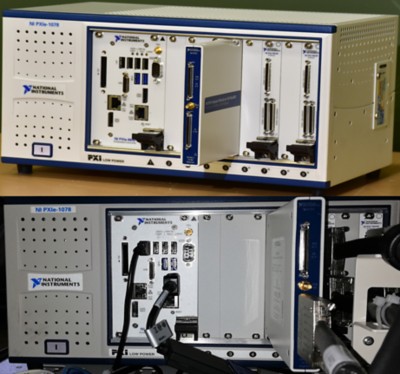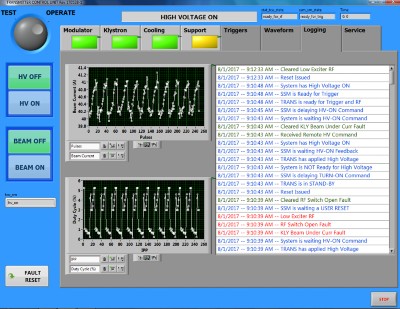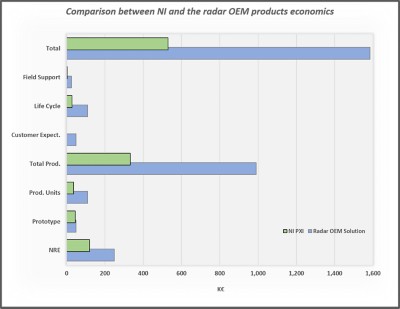Developing a Transmitter Control Unit for a Radar Application
Armando Arenai, NATO Support Agency (NSPA)
The Challenge:
During the 12 months before the first deployment of a state-of-the-art solid-state modulator, we needed to architect, develop, and test a replacement transmitter control unit (TCU) to manage the operation of the modulator’s radar transmitter.
The Solution:
We took advantage of the highly flexible, reconfigurable R Series and FlexRIO products and the short development cycle of LabVIEW FPGA, which offered the perfect solution to meet deadlines and provide inherent savings compared with other commercial off-the-shelf (COTS) or custom products.
"The NI User-programmable FPGA instruments have delivered immediate and striking economic benefits across all project stages, from non-recurring engineering (NRE), to production, to life-cycle management. This has led to a total project cost reduction of more than 50 percent."
—Armando Arenai, NATO Support Agency (NSPA)
The NATO Support and Procurement Agency (NSPA) is a no-profit/no-loss organization that delivers logistics and procurement services to NATO members by providing integrated multinational support solutions. Within this large organisation, our programme supports ground-based radars and other sensor topologies, which constitute the backbone of the NATO air defence system in Europe. With radar systems deployed in the mid-’90s, this programme constantly upgrades the underlying technology to mitigate obsolescence cases and often improves the original system specifications.
The New Modulator
In 2006, the NSPA worked with Stangenes Industries and the radar OEM to develop a Marx modulator based on solid-state devices (for example, IGBTs). The modulator stores sufficient energy during the radar receive period and delivers it in high-voltage form to a high-power final amplifier during the transmit period. The most common design of a radar modulator uses high-voltage levels like those used by the final amplifier (normally above 80 kV). The Marx modulator operates with a standby voltage below 4 kV, which is used to charge multiple capacitors configured in parallel. During the transmit period, these capacitors are switched to a series configuration, which multiplies the high voltage applied to the final amplifier.
This modulator topology features a compact design that eliminates the need for large magnetic circuits, reduces equipment volume due to the decreased level of standby voltages, and significantly improves the transmit pulse characteristics like rise and fall time and pulse-to-pulse stability.
The Design of the TCU
The TCU hosts the human machine interface (HMI) and monitors the various transmitter subassemblies to ensure the proper and safe operation of the entire transmitting system. In the 12 months prior to deployment, the project faced a challenge: the manufacturer doubled the price of the TCU production units because the COTS products used to develop the TCU had become obsolete, and a redesign was necessary.
With a serious threat to the budget and the high risk of a major delay in the delivery of the first modulator, we needed to explore several possible COTS solutions. The NI R Series and FlexRIO products ranked highest thanks to their reconfigurable characteristics and the intuitive programming approach of the LabVIEW FPGA. The entire LabVIEW ecosystem presented a turnkey solution to maintain the overall project’s budget and schedule.
Hardware and Software Integration
The seamless integration between LabVIEW, LabVIEW FPGA, and the hardware we selected minimised the learning curve. The structure of the LabVIEW project environment hides all the hardware integration details from the user, allowing us to focus on the application as opposed to the tedious and complex details of targeting the specific FPGA. Out of the box, the software and hardware delivered their first savings by burying a steep learning curve within the shortened development effort.

We used two PXI-7853R modules, programmed with the state machine architecture, to send commands and receive the status from the modulator:
The first PXI-7853R determines if the high voltage and radar triggers can be applied to the modulator. The analog section of this module is used to monitor the slow analog signals of the modulator.
The second PXI-7853R applies to the remainder of the radar system and the auxiliary equipment of the transmitter, including the cooling system. The analog section of this module monitors the slow signals of the transmitter like the currents of the focus magnets, the voltage and current of the power supply for the klystron, and the ion current.
The PXI-7952R, coupled with an NI-5751 digitizer adapter module, is used for the acquisition, processing, and fault protection of the fast signals, for example, the forward and reverse power of the antenna.
The Economics Behind the Design
We could have easily focused on capital costs when making a purchasing decision for this application, but we recognized the need to take a broader perspective on solution selection. When we considered the competitive cost and flexibility of the NI option along with our significant reduction in development time, we knew the NI solution would give us the opportunity to add new functionality at a low insertion cost. Each project may assign differing weights and tolerances to the schedule and budget, depending on the customer. Achieving success requires a well-proven and supported working environment to minimise development time and cost. This is where LabVIEW software and associated hardware excel, which meant our initial investment produced the most desirable outcome, increasing confidence in the chosen solution.

Exceeding Customer Expectations
Focusing more on the application gave us the ability to develop a more robust application during the first iteration and to reduce the number of failed functional and integration tests. Subsequently, we can use the time gained to exceed customer expectations by either delivering ahead of time or including “nice to have” functions outside the initial scope. In this case, the graphical log in Figure 3 includes the last 256 samples of the final amplifier current along with the instantaneous transmitter duty cycles. This allows the user to pinpoint any system instability without the need for specialized instruments or test setups.
Ownership and In-Field Support
We further reduced cost by taking advantage of the intuitive working environment of LabVIEW and LabVIEW FPGA and by developing the software entirely in house with the assistance of the local NI support services team through NI’s Standard Service Program. Ownership of the software design delivered immediate benefits when, during deployment, we needed to modify and adjust certain functionalities. The integration and test engineers could easily implement software changes directly in the field, which eliminated the need to fund a third party to make those changes.
Diagram ownership is important in the context of life-cycle management. By having full and free access to the VIs and the LabVIEW project structure, we can ensure software support into the future without further investment in dedicated software development workstations and training.

Life-Cycle Management
One underestimated aspect of deploying new equipment is its future supportability. In our domain, the delivery of a product is just one part of the project. Equally important is providing support for the entire life cycle of the equipment. With the pace of evolution of today’s technology, it is easy to fall into early cases of obsolescence. As seen above, electronic components can already be at their end of life during the development cycles, so we must accurately select the latest devices to mitigate these cases. NI has a well-focused product line that allows companies to optimise their investment and maximise revenue. This prevents the problems that companies with diverse portfolios face: the discontinuation of product lines based on annual revenues or the acquisition by other business entities. In either case, engineers may be left without short-term support during the development and logisticians may be left without long-term support.
Furthermore, upgrading new hardware is always tightly coupled with upgrading the development software, which represents a continuous and flawless support service. We saw this again in the structure of the LabVIEW project, which allowed us to simply copy hardware and software resources into the new hardware project folders. In addition, the existing VIs were rehosted without our needing to modify their block diagrams. This simplified migrating the production units to R Series and FlexRIO devices with larger FPGAs to accommodate any future upgrades of the deployed TCU. It took only a few minutes to create a new project, with all existing resources and VIs copied without any changes and the successful compilation of the FPGA on the newly selected RIO devices. We could see how the NI platform offered flexibility for future design iterations and delivered a lower total cost of ownership for life-cycle management.
The Savings Quantified
As discussed in the “The Design of the TCU” section, our original radar OEM solution had doubled in price. The NI user-programmable FPGA instruments have delivered immediate and striking economic benefits across all project stages, from non-recurring engineering (NRE), to production, to life-cycle management (Figure 4). This has led to a total project cost reduction of more than 50 percent.

What Next?
Based on the lessons we learned while executing this project, we are already using other NI products for ongoing projects. We have used the PXIe-5644 vector signal transceiver to replicate the exact behaviour of the radar analog pulse expansion line for obsolescence case resolution. We also used the sbRIO-9651 CompactRIO System on Module (SOM) to implement radar data message protocol conversion. For these cases, the reconfigurability of this hardware and its integration within LabVIEW and LabVIEW FPGA help us save money and time when progressing from the prototype to production phases because we can use the same platforms and minimise the integration effort within the radar system.
